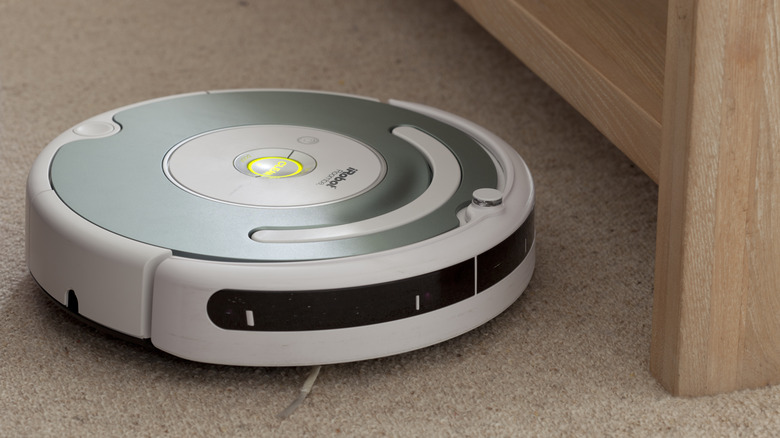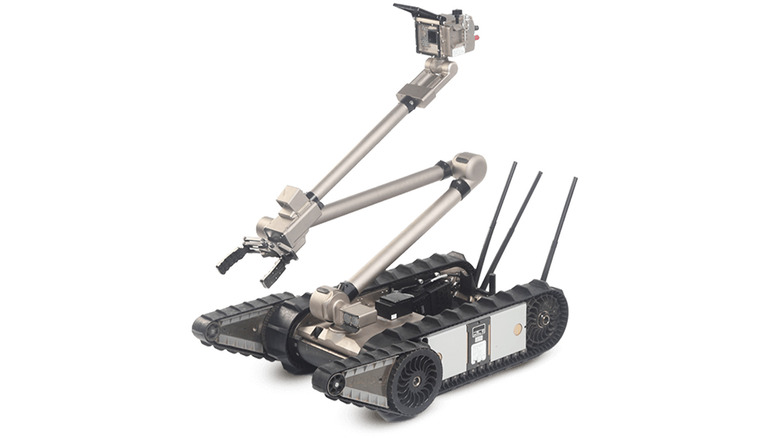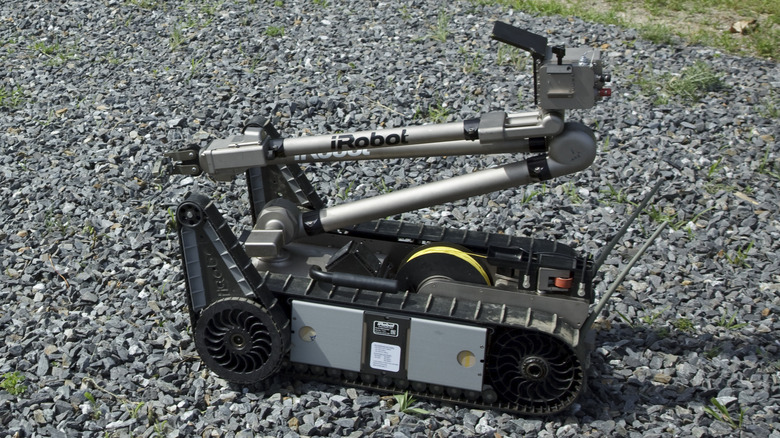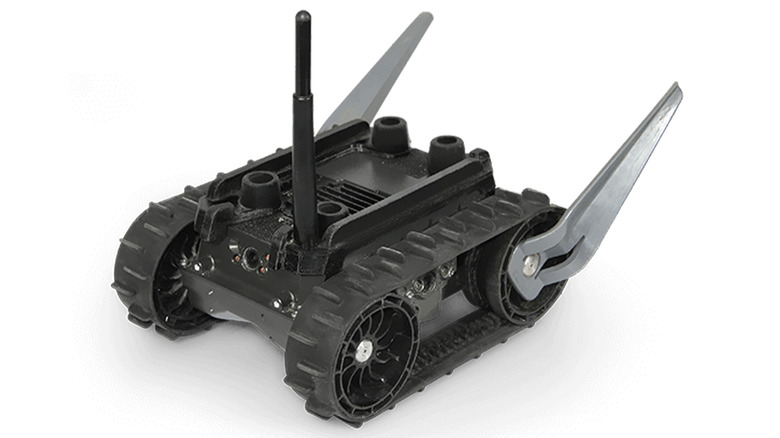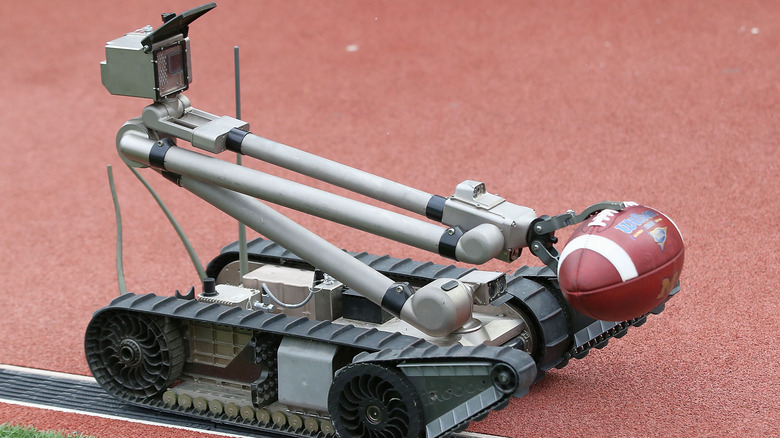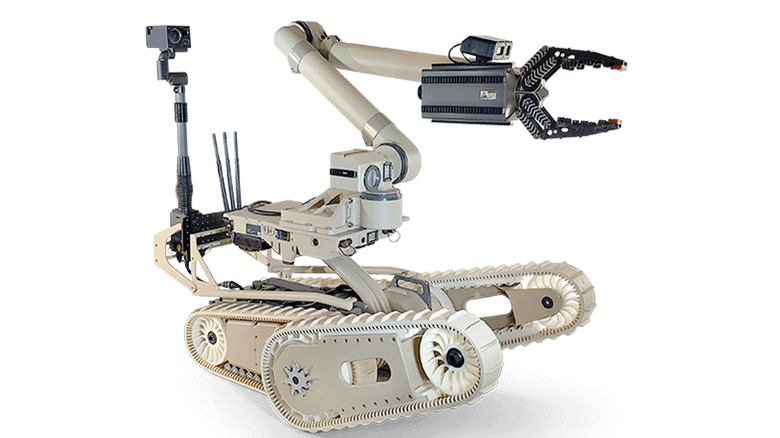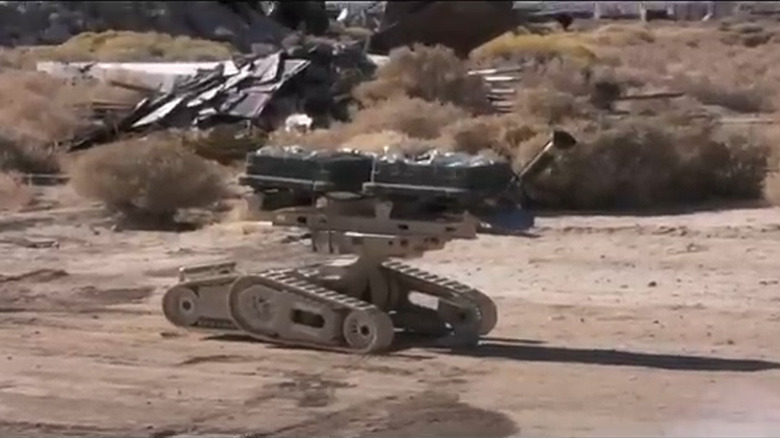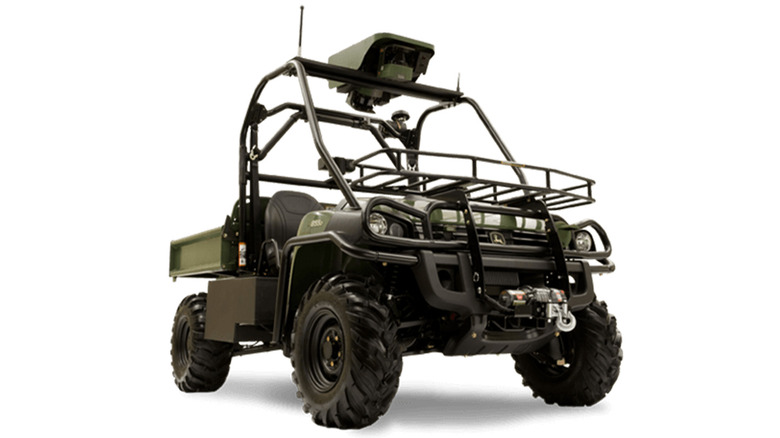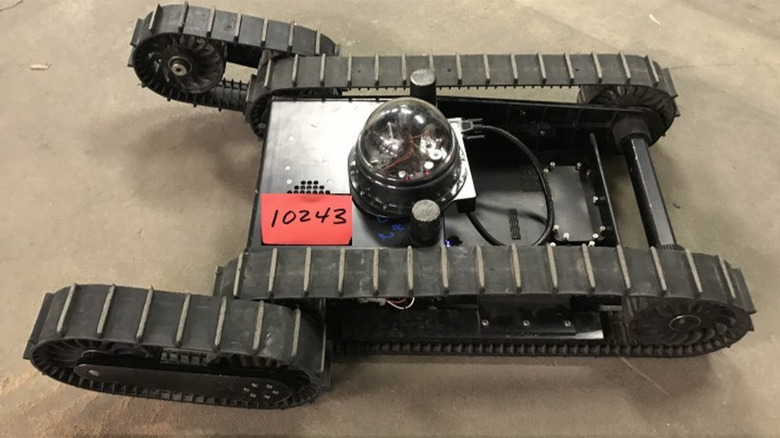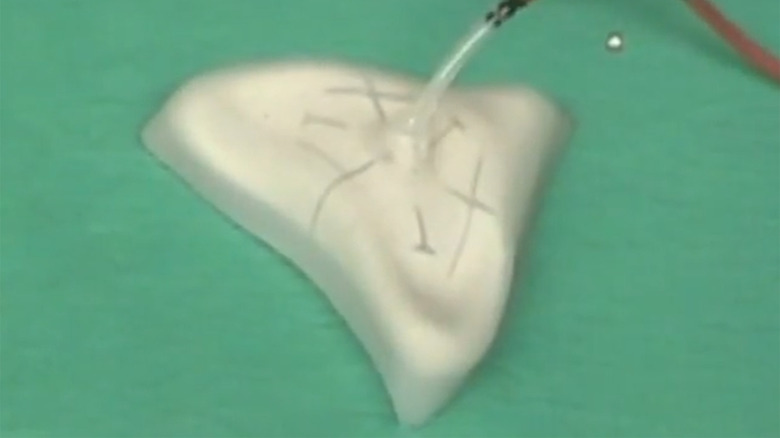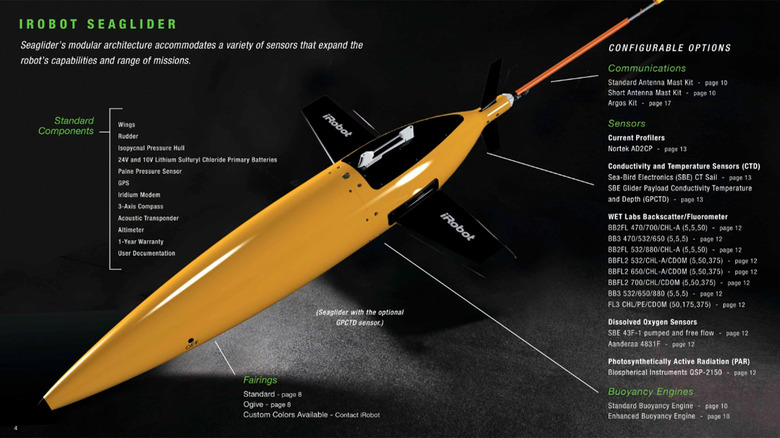10 Military Robots From The Company Behind The Roomba
You likely know iRobot for the Roomba, the robot that vacuums your floor for you. It's one of the most successful robotic vacuum brands of all time. They crossed the 30 million sales mark in 2021 and have become a household name. The Roomba has almost become synonymous with robot vacuums the same way Band-Aids have become synonymous with adhesive strips. It's an earned distinction since iRobot has been making the Roomba since 2002. In short, iRobot is a big company with one of the most successful smart home products ever made.
However, iRobot's beginnings were quite different from its household-friendly image today. The company was founded in the early 1990s by MIT roboticists Colin Angle, Helen Greiner and Rodney Brooks. From its founding until the Roomba in 2002, iRobot made its bones by making robots for the United States military. The first such effort was called the Ariel. It was a crab-like robot that the military deployed to help deal with mines that might be hidden along the shoreline. From there, iRobot made several other robots up through the Roomba release for more than two decades.
In 2016, iRobot sold its military division to focus on household robots like its Roomba lineup. The buyers spun the arm off into its own entity called Endeavor. It was then sold again to Teledyne Flir, which currently sells robots to the military and police. iRobot isn't the only household name that's made military technology. Samsung, for example, has made machine gun robots for the military before.
The PackBot
The PackBot was one of iRobot's first military-oriented robots. It was part of a 1998 DARPA contract that iRobot won to create a mobile robot soldiers could carry around on the battlefield. It's designed to be deployed in under two minutes and can easily be stowed away in the trunk of most vehicles. Some of its other talents include climbing stairs, navigating rougher terrain, and fitting into narrower passages. The PackBot has been iterated several times since its invention and is still sold today by Teledyne Flir.
Of the robots on the list, the PackBot has one of the most interesting histories. It made its debut after the September 11th attacks, and assisted search and rescue teams in finding people still trapped in the rubble. A year later, the first PackBot deployed with US troops. The PackBot is primarily used for bomb disposal, surveillance, and reconnaissance. It can also be equipped to handle CBRN detection and hazmat handling. Operators stand a safe distance away and use the PackBot's tablet to navigate and control the PackBot's three-link articulating arm. The arm can lift up to 30 pounds.
In addition to military operations, the PackBot has been known to assist in police SWAT operations and engineering reviews in the civilian sector. Teledyne Flir boasts 75 optional accessories for the Model 510, and there is also a Model 525, which is more modern than its predecessor. Between the various accessories and existing equipment, the PackBot is shockingly useful for both civilian and military uses.
The 310 SUGV
Just a few short years later, iRobot would win another military contract to develop the SUGV series of military robots. The order was for $11 million, and iRobot made 70 of these robots for the Army at the beginning. The SUGV, which stands for Small Unmanned Ground Vehicle, is another portable robot that the military would use for operations. They have a similar design to the PackBot but are both smaller and lighter than its predecessor. As such, the SUGV is slightly less capable than its older brethren but easier to carry around.
The specs on the 310 SUGV are fairly impressive for a robot developed in 2004. Its battery pack allowed it to operate for about 90 minutes before needing a charge. Like the PackBot, operators use a remote control to move the robot around and use its arm to lift things. The maximum carrying capacity of the SUGV is rated at 12 pounds if its arm is fully extended or 22 pounds if the object is closer to the bot. It can also travel at 6.2 mph and turn on a dime. Like the PackBot, there are plenty of accessories that can plug into the bot's four expansion ports.
The military purchased a number of SUGV units over the years, all at great expense. In all, hundreds were built and dispersed into the military, including backups and spares. One of the final orders was to the US Marine Corps that saw 75 bots delivered for $9.8 million. The Future Combat Systems (FCS) program for which the bot was made was eventually canceled, but Teledyne Flir still sells the SUGV 310 to this day.
The FirstLook
iRobot would continue developing smaller and smaller robots, which included the FirstLook robot in 2011. This one took transportable to the next level. It's smaller than the SUGV and PackBot. At 10 inches long, four inches high, and a weight of five pounds, this thing can literally be thrown all over the battlefield. In fact, iRobot used the term "throwable" multiple times in its official press release when it announced the existence of the FirstLook, and can survive drops of up to 15 feet onto solid concrete. Naturally, the military bought an undisclosed number of these robots for $4 million when they first came out.
Its small, throwable nature made it great for the same types of missions that the military was already running with the PackBot and SUGV. The FirstLook's primary functions were explosives detection, ordnance disposal, bomb disposal, and detection of chemical, biological, radiological, and nuclear agents. It could also inspect vehicles and clear buildings while the operator sat safely outside. Perhaps its most unique feature is the capability to establish digital mesh networking, allowing radio operators to relay communications over greater distances.
Much like its larger brethren, Teledyne Flir keeps a selection of these available for purchase and they have been iterated upon since the initial release. The robot can now survive drops of up to 16 feet and weighs 6.6 pounds. Combine that with its all-weather protection and the ability to flip itself over and be submerged in water up to three feet deep and the result is a military robot that can do a lot.
Warrior
iRobot came up with the 710 Warrior in 2012 and it came with a very familiar design. It looks and operates very similarly to the Packbot and SUGV. The biggest difference is its size and power. Where the older iRobot bots were made to be carried by soldiers on the battlefield and had carry and weight restrictions to work around, the Warrior was designed with no such restrictions in mind. This robot weighed 300 pounds. Wherever it went, it drove itself.
In addition to its heftier weight, the robot was capable of carrying much heavier loads. iRobot says that the Warrior could carry more than 150 pounds and lift up to 220 pounds depending on how far the arm had to extend to pick up the object. That's enough power to carry a human person. However, its primary uses were similar to other robots in iRobot's lineup. Militaries and police organizations used the bot primarily for roadside bomb detection, reconnaissance, chemical detection, and radiological agents. It served its purpose well until it was replaced by an upgraded model later.
One of the Warrior's most famous roles was helping to clean up the Fukushima Daiichi nuclear power plant incident. iRobot provided two Packbots and two Warriors to wade into highly irradiated zones to measure radiation levels and help clean up debris. The lovely irony being that iRobot was very famous for its Roombas at that point and even the military robots were helping to clean up messes.
Kobra
iRobot would continue its efforts on the 710 Warrior with the 710 Kobra. The robot came onto the market in 2015 when iRobot started receiving orders for it from the U.S. military and even some foreign militaries. It's technically an upgraded model from the Warrior, and has many of the same capabilities. It's also a lot stronger than the Packbot, with the ability to lift up to 330 pounds if the object is close to the robot.
Since it is one of the newer robots on the list, it had some technological upgrades from the older bots. It communicates using a 2.4 GHz or 4.9 GHz wireless signal but can also be tethered to its controller as well. Also, where older models only had between one and two hours of battery life, the Kobra was capable of running for six to 10 hours on its battery pack. It's also bigger, heavier, faster, and more water resistant than prior models with a full IP67 rating. Unlike most of its stablemates, this one was also available as a toy.
It was also one of the last ones. iRobot would sell its military arm in 2015, so it's likely that the company actually handled very few of the deliveries of this robot since organizations started ordering it that same year. Teledyne Flir not only still makes this robot but has since upgraded it to the Kobra 725, which is more modern and more powerful than the original.
APOBS
iRobot's military bots were best known for their articulating arms and track-style treads, similar to what tanks use. However, some bots were designed to do things other than roll, detect, and move. The APOBS is a good example of this. It's technically an attachment that was fitted for iRobot's Warrior model robot, but it's easily one of the most terrifying things that iRobot ever produced. For the record, it fires an explosive line charge towed by a rocket that is made to clear areas 45 meters long and two-thirds of a meter wide.
This YouTube video shows the capabilities pretty well. Essentially, an APOBS — or anti-personnel obstacle breaching system — attaches to a Warrior and then its driven out to the danger zone by the Warrior's operator. When it fires, it lays down explosive charges for 45 meters. Once it detonates, any mines or tripwire traps in that line are blown sky-high. It's not meant as a weapon against humans, but you would be forgiven for mistaking it for one. Watching it fire a 45-meter line of explosives does look very cool, though.
APOBS was developed in conjunction with the Naval Air Warfare Center Weapons Division (NAWCWD), the U.S. Army Tank Automotive Research, Development, and Engineering Center (TARDEC), and the U.S. Marine Corps Forces Pacific Experimentation Center (MEC). The testing for the APOBS took place in 2009 so that's likely when it started being used by the military.
R-Gator
The R-Gator is one of the more unique creations from iRobot. The company was formed in 2005 via a partnership with John Deere, and it mixes iRobot's robotic smarts with John Deere's ability to make a vehicle. Together, the two concocted an autonomous ground vehicle that could be driven manually or operated by remote control, similar to other iRobot bots. It is the largest item on this list and while it's not technically a robot, it includes a lot of the same functionality and technology as the other bots on the list. It could be driven in six different ways: manual, teleoperation, waypoint, directional driving, playback, and silent sentry mode.
The R-Gater, which is short for Robotic Gator, was made to serve in the same way as iRobot's other bots. It would perform reconnaissance both on road and off road while relaying real-time video, sounds, and sensor readings to its operator. Since it was a vehicle, it could also autonomously shuttle supplies between rear supply points and forward operating positions while also carrying gear and injured soldiers around. Upgrades give it sensors that can detect hazardous materials, which allows it to be used on ordnance disposal missions as well. In silent sentry mode, the vehicle could keep its surveillance sensors on while turning off the engine, allowing the vehicle to quietly gather information.
The R-Gator was built using John Deere's M-Gator platform, which John Deere uses for its Gator lineup of utility vehicles. iRobot mostly provided the technology to make it autonomous along with the sensors, iRobot's obstacle avoidance system, and other technology that iRobot had previously only stashed in its military robots.
Negotiator
Technically, the iRobot Negotiator was never made for military use. Instead, iRobot developed this bot for police forces in the US. It was built to be a cost-effective solution for police departments that didn't have the budget of the military-industrial complex. It launched in 2008, so it was one of iRobot's earlier bots meant for military or police use. It shares a few design elements with the PackBot but omits the PackBot's articulating arm. However, that doesn't make the bot any less capable than its larger, more expensive siblings.
For the most part, the Negotiator was built for basic reconnaissance missions performed by police and fire departments. As an example, a firefighter may send the robot into a burning building to scope out the damage and extent of a fire. Police may drive the bot into a building to check and see if there are any bombs present. It featured myriad sensors and a camera so that the operator could effectively maneuver the bot. iRobot also developed a range of accessories that allowed the Negotiator to do other things like detect hazardous materials.
The Negotiator was made for police and firefighters, but did make its way into the hands of more serious organizations. Add-ons allowed it to detect chemicals, and it made its way into the hands of some counterterrorism and domestic security professionals as well. It certainly isn't the most well-known of iRobot's portfolio, but you can still find these used on the market if you look around enough.
Chembot
The Chembot is easily one of the most unique robots that iRobot—or any bot maker—has ever released. It is a shapeshifting blob that uses its squishy body to shift its shape and move around. iRobot developed the Chembot with the University of Chicago. This robot is quite small and fits in the palm of the user's hand. In addition, users can stretch and shape the blob without breaking it. Honestly, the bot looks like something out of a sci-fi horror movie.
Here's how it works. It has an elastic polymer shell that can change its shape. The mechanisms inside the Chembot inflate and deflate different compartments to change the bot's shape. The changes in shape help propel the bot forward as it rolls over surfaces. The material inside the compartments are particles that move when air is inserted and removed from the compartments. There is also a layer of liquid that assists in the bot's various mechanics. In design documents, these mechanisms are referred to as "jamming skin-enabled locomotion" and it's really quite funky to watch.
The Chembot sounds like it's used for detecting chemicals and things like that, but the name is more about what the bot is made out of rather than what it does. DARPA funded the project for $3.3 million as a reconnaissance bot. Its ability to inflate and deflate, change shape, and move around in very constricted or oddly shaped areas, like small holes between pieces of furniture and things like that. This bot never saw the light of day, but at one point, iRobot considered fitting it with sensors so that it could do its job properly.
Seaglider
The iRobot Seaglider was made more for governmental agencies rather than military use, but it was one useful robot. The Office of Naval Research originally funded the project starting as early as 1995. Upgrades and developments happened over the years, and iRobot released the final, enhanced version of the Seaglider in 2011. The bot sported a torpedo shape and was made for underwater jobs. It's also bigger than it looks in its pictures. The Seaglider was approximately six and a half feet long and about a foot in diameter.
The Seaglider is capable of a bunch of different jobs. There are sensors that can measure various underwater metrics like plume forecasting and current profiling. There is a payload bay that lets users transport things from one place to another. There are also hard drives onboard so the Seaglider can collect data over a long period of time. According to iRobot's brochure, the battery can last upwards of 10 months under the right conditions. It's also equipped with GPS and other sensors for navigation during deeper dives and longer adventures.
There are over 100 Seagliders in existence and they have studied the waters off of various countries around the world. Its most famous mission was to study the Gulf of Mexico after the Deepwater Horizon oil spill in early 2010. Seagliders on the mission were outfitted with sensors that could detect oil droplets in the water and were tasked with finding large clouds of oil in deeper waters that might have affected sea life and vegetation.
